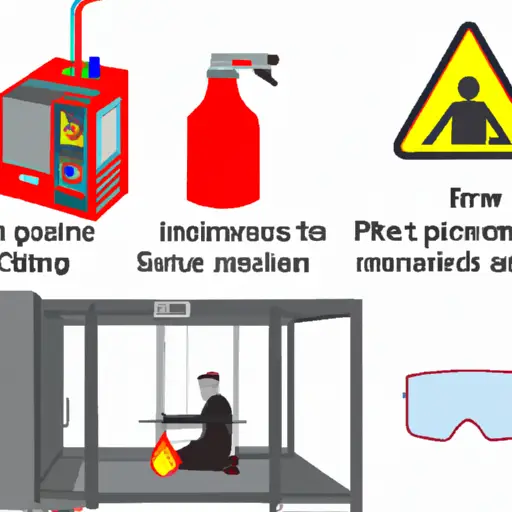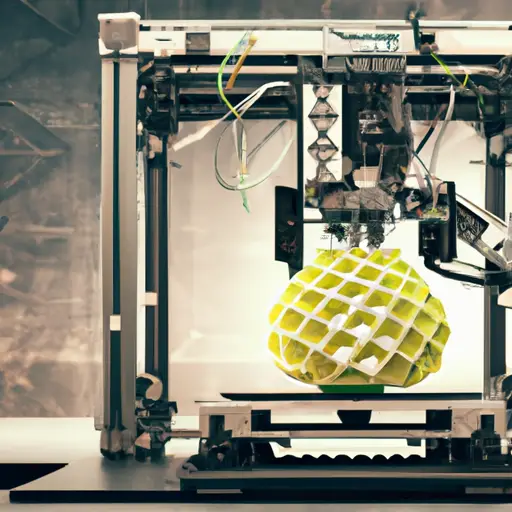In a world where precision and efficiency are paramount, the clash between two 3D printing techniques, Stereolithography (SLA) and Fused Deposition Modeling (FDM), has captivated the attention of industries far and wide.
While SLA promises intricate details and smooth finishes, FDM boasts affordability and versatility.
This article aims to provide a comprehensive overview of these printing techniques, exploring their advantages, limitations, material options, and applications.
Prepare to delve into the fascinating realm of SLA versus FDM printing, where innovation meets possibility.
Advantages and Disadvantages of SLA Printing
When considering the advantages and disadvantages of SLA printing, it is important to carefully evaluate its capabilities and limitations.
SLA, or Stereolithography, is a 3D printing technology that uses a UV laser to cure liquid resin into solid objects layer by layer. One of the major advantages of SLA printing is its high level of detail and accuracy, making it ideal for creating intricate and complex designs. Additionally, SLA printing can produce parts with a smooth surface finish, reducing the need for post-processing.
However, there are some drawbacks to consider when using SLA printing. Firstly, the cost of SLA printers and resin materials is generally higher compared to other 3D printing technologies, such as FDM. This makes it less accessible for individuals or small businesses on a tight budget. Furthermore, the printing process in SLA is generally slower compared to FDM printing. This is because each layer needs to be cured individually, resulting in longer print times.
Despite these disadvantages, SLA printing offers certain advantages that make it a preferred choice for certain applications. Its high level of detail and accuracy, along with the smooth surface finish, make SLA printing suitable for creating prototypes, jewelry, and dental models. Additionally, SLA printing is widely used in industries such as automotive, aerospace, and medical, where precision and quality are paramount.
Benefits and Limitations of FDM Printing
One of the key advantages of FDM printing is its versatility in terms of material options and the ability to create large-scale objects. Fused Deposition Modeling (FDM) technology offers a wide range of materials that can be used for printing, including various types of thermoplastics, such as ABS and PLA. This allows users to choose the most suitable material for their specific application, whether it’s for prototyping or end-use production.
Additionally, FDM printing is capable of creating large-scale objects. Unlike other 3D printing technologies, FDM printers can accommodate larger build volumes, enabling the production of objects with dimensions that would not be possible with other techniques. This makes FDM printing a suitable choice for industries such as automotive, aerospace, and architecture, where the production of large parts is common.
However, despite its advantages, FDM printing also has limitations. One limitation is the relatively lower level of detail and resolution compared to other printing techniques such as SLA. The layer height in FDM printing determines the level of detail, and smaller layer heights result in higher resolution but slower printing speeds. Another limitation is the need for support structures when printing overhangs or complex geometries, which can increase post-processing efforts.
To summarize the benefits and limitations of FDM printing, refer to the table below:
| FDM Printing Benefits | FDM Printing Limitations |
|---|---|
| Versatility in material options | Lower level of detail compared to other techniques |
| Ability to create large-scale objects | Need for support structures |
| Wide range of applications | Longer printing times for higher resolution |
Material Options for SLA and FDM Printing
Both SLA and FDM printing offer a wide range of material options to cater to different application requirements.
When it comes to material types, SLA printing primarily uses photopolymer resins, which are liquid polymers that solidify when exposed to ultraviolet light. These resins come in various formulations, including standard, tough, flexible, and high-temperature resistant resins.
On the other hand, FDM printing utilizes thermoplastics, such as ABS (Acrylonitrile Butadiene Styrene) and PLA (Polylactic Acid). ABS is known for its durability and impact resistance, making it suitable for functional prototypes and end-use parts. PLA, on the other hand, is a biodegradable and environmentally friendly option that is commonly used for concept models and low-stress applications.
In terms of cost comparison, SLA printing materials are generally more expensive than FDM printing materials. The photopolymer resins used in SLA printing can be quite costly, especially for specialized formulations. On the other hand, FDM printing materials, such as ABS and PLA, are more affordable and widely available in the market. Additionally, FDM printers have the advantage of being compatible with third-party filaments, allowing for a wider range of material options at varying price points.
Precision and Detail: a Comparison Between SLA and FDM
The precision and detail achieved in SLA printing surpasses that of FDM printing, making it the preferred choice for applications requiring intricate and highly accurate designs. When comparing the accuracy of SLA and FDM printing, it is important to consider factors such as resolution and layer thickness.
SLA printers utilize a laser or projector to cure liquid resin layer by layer, resulting in high-resolution prints with fine details. The typical resolution of SLA printers ranges from 25 to 100 microns, allowing for intricate designs and smooth surfaces. On the other hand, FDM printers extrude molten filament through a nozzle in a layer-by-layer fashion. The resolution of FDM printers is generally lower, ranging from 100 to 400 microns, which can result in visible layer lines and less precise details.
To further illustrate the accuracy comparison between SLA and FDM printing, the following table highlights the key differences in resolution and layer thickness:
| Technique | Resolution (microns) | Layer Thickness (microns) |
|---|---|---|
| SLA | 25-100 | 25-100 |
| FDM | 100-400 | 100-400 |
As shown in the table, SLA printing offers higher resolution and thinner layer thickness, resulting in more accurate and detailed prints compared to FDM printing. This makes SLA printing ideal for applications that require intricate geometries, fine textures, and high precision.
Applications and Industries for SLA and FDM Technologies
SLA and FDM technologies find extensive use in various industries and sectors due to their unique capabilities and applications. These technologies have revolutionized the manufacturing and prototyping processes, offering cost-effective and efficient solutions. Some of the applications of SLA technology include:
-
Rapid Prototyping: SLA allows for the quick production of prototypes with high precision and intricate details. This is particularly useful in industries such as automotive, aerospace, and consumer electronics.
-
Medical and Dental: SLA technology is widely used in the medical and dental fields for the production of custom implants, prosthetics, anatomical models, and surgical guides. Its ability to produce complex shapes and accurate details makes it suitable for these applications.
-
Jewelry and Fashion: SLA printing is used in the jewelry industry to create intricate and detailed designs that cannot be achieved through traditional manufacturing methods. It is also used in the fashion industry for prototyping and producing unique accessories.
On the other hand, FDM printing is commonly used in industries such as:
-
Aerospace and Automotive: FDM technology is used to produce lightweight and durable components for aircraft, drones, and automobiles. The ability to print large parts with high strength makes it an ideal choice for these applications.
-
Manufacturing and Tooling: FDM printing is used in the production of jigs, fixtures, and tooling for manufacturing processes. It offers quick turnaround times and cost-effective solutions for producing custom tools.
-
Education and Research: FDM technology is widely used in educational institutions and research facilities for teaching and conducting experiments. Its affordability and ease of use make it accessible to students and researchers.
Frequently Asked Questions
What Are the Cost Factors to Consider When Choosing Between SLA and FDM Printing Techniques?
When choosing between SLA and FDM printing techniques, cost factors and material selection are crucial considerations. The cost factors to consider include equipment cost, material cost, maintenance cost, and post-processing cost. Additionally, material selection should be based on the desired properties and application requirements.
Are There Any Safety Concerns Associated With Using SLA or FDM Printers?
When using SLA or FDM printers, it is important to consider safety precautions and ventilation requirements. Both techniques involve the use of potentially hazardous materials and emit fumes, so proper ventilation and personal protective equipment should be used to minimize any associated risks.
Can SLA and FDM Printers Be Used to Print Functional Prototypes?
Yes, both SLA and FDM printers can be used to print functional prototypes. When comparing costs, FDM tends to be more cost-effective due to lower material costs. Additionally, both techniques have a wide range of material compatibility options.
What Are the Typical Post-Processing Steps Required for SLA and FDM Printed Parts?
When it comes to post-processing steps for SLA and FDM printed parts, there are several common techniques used, including sanding, polishing, painting, and adding additional components. These finishing techniques ensure the desired final appearance and functionality of the printed parts.
How Does the Build Time Differ Between SLA and FDM Printing Techniques?
The build time in SLA and FDM printing techniques differs significantly. SLA printing is typically faster due to its layer-by-layer curing process, while FDM printing requires the extrusion of material, resulting in a slower build time. However, FDM offers advantages in terms of larger build volumes and reduced material waste.
Conclusion
In conclusion, when comparing SLA and FDM printing techniques, both have their own set of advantages and disadvantages.
SLA printing offers high precision and detail, making it suitable for industries such as jewelry and dentistry.
On the other hand, FDM printing is more cost-effective and offers a wider range of material options, making it popular in industries such as prototyping and manufacturing.
Just like two sides of a coin, these techniques complement each other, catering to the diverse needs of various applications and industries.




